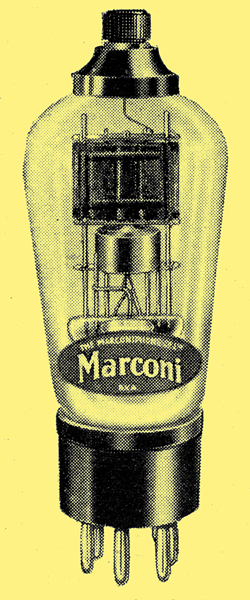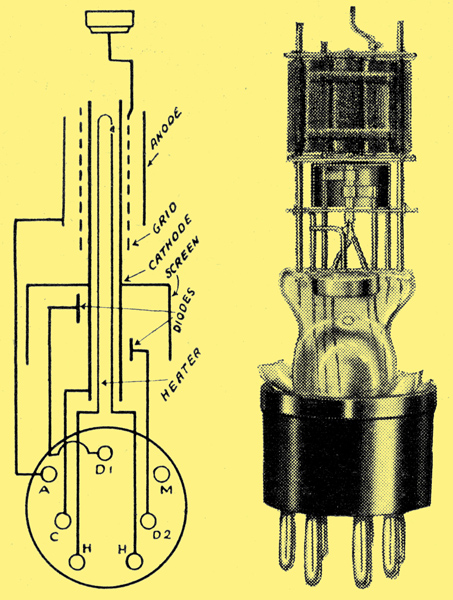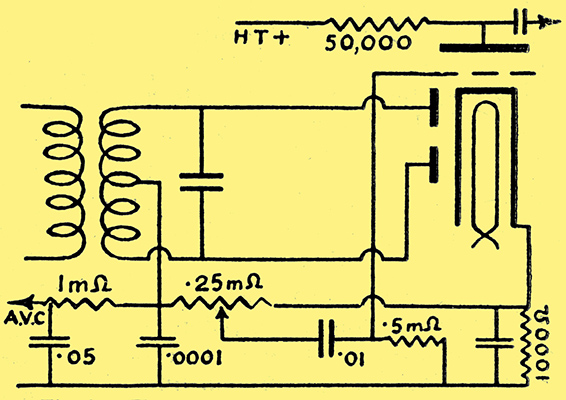|
A valuable development in valve technique which has already created considerable interest and is assured of wide use in the near future, - particularly in circuits of the AVC type.

Fig. 1. The MHD4 has been developed especially for automatic volume control, and consists of one triode and two diode valves in one bulb.
The double-diode triode is a valve developed specially for use in Automatic Volume Control circuits. As its title implies, it consists of two diode rectifiers and a triode amplifier contained in the same bulb. Reference to the photograph of the new Marconi MHD4 in Fig. 1 will show that in construction the upper portion is very similar to the normal indirectly-heated triode of the MH4 class.
Shielding the anode of this triode from the lower portion of the construction is a metal screen connected to the cathode, and beneath this are supported the two auxiliary anodes of the diodes. The function of the screen is to ensure that the capacity between these auxiliary anodes and the anode of the triode shall be as low as possible, so that the minimum amount of radio-frequency energy or high audio-frequency energy is passed on directly from the rectifier to the amplifier section of the valve.
Connections

Fig. 2. The relative positions of the electrodes are well illustrated in this diagram and photo. Note how the two diodes are screened from the triode by a shield connected to the cathode.
Connection to the grid of the triode is made via the terminal at the top of the valve, while the disposition of the pins in the base and their connection to the other electrodes is shown in Fig. 2.
For use in a simple AVC circuit the double-diode triode may be connected so that full-wave rectification of the signal takes place between the two auxiliary anodes and the cathode. The rectifier voltage is then applied across the ends of a potentiometer from the slider of which connection is taken via a coupling capacitor of about 0.01 μF. to the grid of the triode. Thus the AC portion of the rectified signal is led off to be amplified, the potentiometer acting as a manual volume control.
Low Damping
Meanwhile, a DC voltage (due to the rectified carrier-wave) is developed in the resistance. This is a measure of the strength of the incoming signal, and may by applied as bias to variable-μ valves in the preceding stages, whether used as radio-frequency or intermediate-frequency amplifiers.
Consideration of this arrangement will show the main advantages of the use of the double-diode triode.
Firstly, the damping effect of the rectifier on the preceding HF stage is low, due to the high input impedance of the diode. Actual measurements made on diodes under working condition show that the effective shunt damping impedances are of the order of ½ the value of the load resistance across which the rectified voltage is applied - i.e. between 100,000 and 250,000 Ω.
Distortion-less Rectification
It is well known too, that diode rectification is one of the best methods of distortion-less detection over a wide range of input voltages besides being between 80-100% efficient.
A third advantage results from the separation of the rectifier and amplifier portion of the circuits. With the efficient screening between the diode anodes and the grid and anode of the triode, the amount of LF signal available from the triode becomes independent of the depth to which the incoming signal is modulated.
The characteristics of the Marconi MHD4 at zero grid bias with 100 Volts on the anode are: amplification factor - 40, impedance -18,200 Ω and mutual conductance - 2.2 mA/V.
The double-diode triode may also be used effectively in circuits for QAVC, the one diode-anode circuit being used to provide half-wave rectification and simple AVC and the other diode so as to provide bias volts, so that no signal is passed unless of more than a definite value. This pre-determined voltage is set to be somewhat higher than the average voltage from mush noises, etc., so that until this value is exceeded by the incidence of a signal the receiver remains quiet.
Many Interesting Arrangements

Fig. 3. The connections for using a double-diode triode for full-wave rectification and automatic volume control.
From the above it will be realised that many interesting arrangements may made using the MHD4 For example, one diode may be used to delay the action of the AVC operation of the other so that the control does not come on until the detector is about to be overloaded.
Several circuits have been developed, and it is hoped to follow this article with one on which the various arrangements and their applications are discussed.
|